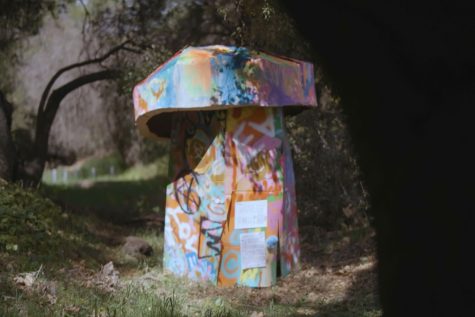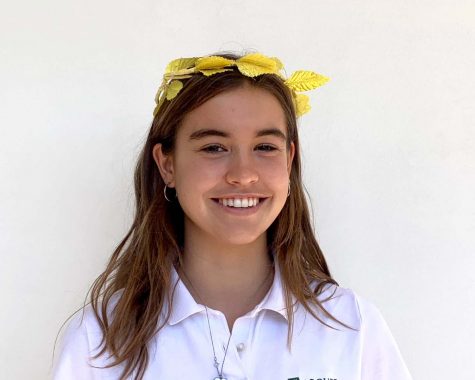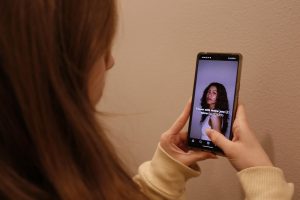When English and art collide: Senior Bess Frierson opens ‘The MUSH Room’
Photo credit: Harlow Schuman
A still from senior Bess Frierson’s film, “Mush Room,” is pictured above. Frierson opened her senior show in the Eastern Star Gallery March 14, where visitors watched the five minute film projected on a wall.
March 31, 2022
What began as a larger-than-life cardboard mushroom later transformed into a film of childhood, identity, life and death. For Bess Frierson’s senior art show, she adapted her visual art from English class into the gallery exhibit “The MUSH Room.” The exhibit opened March 14 in the Eastern Star Gallery. Described by Frierson as an “ode to classic fairy tales, fantasy, escapism and a coming of age story,” the exhibit featured a short film and objects in glass.
The origin of the exhibit can be traced back to English teacher Brian Wogensen’s Literature of Fairy Tale & Fantasy class. After reading “Alice in Wonderland,” Wogensen assigned Frierson “the non-essay assignment,” which Wogensen described as a “cross curricular marriage.” Students, like Frierson, incorporated artistic elements into their final product.
“What’s beautiful is that you can see the process that Bess went through to reach this refined piece of art — the film,” Wogensen said. “That started with writing down thoughts about ‘Alice in Wonderland,’ and then becoming introspective and reflecting and doing writing that then turned into visual experience.”
Composed of spray-painted cardboard and an interior of “nonsensical, fantastical prose,” the mushroom reflected both messages from the book as well as Frierson’s personal life. The recycled cardboard was similar to the prose written in Frierson’s childhood, reflecting on the concept of creating life from things that have ended or died.
“The idea was for it to feel like a safe space to project anxieties, maturity and just to have a cathartic release of all those feelings,” Frierson said. “A big part of it was the idea that mushrooms grow from death. I had a lot of notions of how the world should be, how I should feel, how I should act, and I think from that death grew something beautiful which is me and my soul, my personality. So that mushroom really feels like me in this new phase of my life, growing from something that’s died but creating new life from the same materials.”
In the Literature of Fairy Tale & Fantasy senior seminar, students examined the book through various lenses and themes, which Wogensen said he saw arise in Frierson’s work.
“One of [the lenses] is the psychoanalytical lens, and Bess definitely ran with that and the theme of identity and identity formation and questioning identity that Alice does throughout that text,” Wogensen said. “The interior and the exterior surface I think is really interesting in the way it is almost graffiti-esque, but also, there’s a childish or childlike quality to it, and that’s another tension in ‘Alice and Wonderland’ — between the adult world and the child world.”
This tension and observation of childhood emerged in her film “Mush Room,” which Frierson projected onto a wall in the gallery. The coming-of-age story follows a girl’s first experience with mortality as she watches her grandfather die and has to deal with ensuing feelings and changes.
“Something that was super interesting to me in fiction and fairy tales was the use of fantasy to cope with maturity and a changing world. We are acutely aware of the fact from a pretty young age that we are going to have to grow up and there is going to be no more fantasy,” Frierson said. “As a senior, I’m on the brink of what I know is going to have to be a huge learning curve, and what I know is going to completely change — everything I know to be true and all my fundamental relationships, my fundamental perspectives on life.”

Converted from a 20-page script and 30-minute film to a five-minute film, “Mush Room” underwent many changes in the editing stage. Frierson attributed this mainly to art teacher Chad Attie, who encouraged her to pursue this art piece and find a way to share it.
“Something Mr. Attie said — which I value his critique so much — is that when you’re making a piece like this, you want to strip it down to the absolute essentials, cut it down to just that and it’ll be much more impactful,” Frierson said. “So I just chose what I felt was the core of it.”
Attie, who originally encouraged Frierson to “investigate [the mushroom], study it and have fun with it,” described his advice in relation to the development of the film.
“I told Bess about a quote that I love [from] French writer Antoine de Saint-Exupery, and the quote goes as follows: ‘Perfection is achieved not when there is nothing more to add, but when there is nothing left to take away,’” Attie said. “I think she needed to take away things and pare down things. And I gave her the advice [that] she doesn’t have to give everything away. It’s sometimes way better to keep things in and let the viewer wonder.”
Originating in an English class and traveling to the courtyard, then to the Visual Arts Fair for community artists and eventually the gallery, Wogensen said the mushroom took on a life of its own in the Archer community. He noted the impact of her expansive project.
“Every time a student does something like this, it lets other students recognize that there’s possibility. The horizons are really, really wide and far from what [they] can possibly do,” Wogensen said. “That’s a great gift.”










